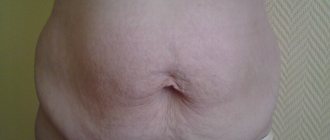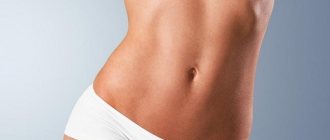General information about subcutaneous fat
Subcutaneous fat is the deepest layer of the epidermis. It is represented not only by lipids. The layer looks like connective tissue with fatty lobules. At the chemical level, fat is a group of simple lipids. Their composition may include esters, alcohols, high molecular weight carboxylic acids, etc.
Subcutaneous fat is located under the top layer of the epidermis.
Reasons for appearance
Fat is formed in the human body after every meal. It is synthesized from lipids and carbohydrates. Adipose tissue represents an energy reserve. They appear when the body does not have time to expend all the incoming calories.
A small amount of fat is required by the body for proper functioning, so it is formed even with a balanced diet.
Most often, the question about the reasons for the appearance of lipids arises when the stomach grows, skin folds form, etc. This occurs due to the following factors:
- Poor nutrition. Obesity often develops due to overeating or an incorrectly formulated diet. Eating large amounts of fast carbohydrates does not contribute to long-term satiety, which is why a person snacks more often. In most cases - high in calories. Another danger is lack of a schedule. Skipping meals due to being busy leads to attempts to catch up during dinner. Since the body does not burn calories at night, a double portion is deposited on the stomach and sides as fat.
- Sedentary lifestyle. Sports help you burn calories and shape your figure. With a sedentary lifestyle, muscle fibers are destroyed, which consume energy even at rest.
- Bad heredity. The enzymes responsible for breaking down lipids may not work as well as they should.
- Exposure to stress. When a person is nervous or preparing to overcome any obstacle, his hormonal balance changes. As a result, cortisol is released. In the short term, it briefly increases physical strength and agility. If a person is often or for a long time in a state of stress, he experiences depression, fatigue, and lack of energy. There is a desire to cheer yourself up with food.
- Psychological problems. Eating disorders are almost always associated with mental disorders. It can be caused, for example, by a feeling of guilt. In this case, food becomes the most accessible and simple source of pleasure and relief from mental stress. Most often, benevolent people who are always ready to help suffer from overeating, because they give too much energy to the external environment. As a result, they have a need to fill the gap.
- Hormonal imbalances. If the balance is imbalanced, a person can either lose weight or rapidly gain it. Hormones change appetite. An increase can occur even against the background of the usual diet. This happens if, due to hormonal imbalance, the body goes into a state of economy. As a result, a person receives the daily amount of calories, but the body stores most of them. The body suffers from a lack of energy, because it saves on many functions.
- Illnesses. First of all, endocrine pathologies pose a danger. These are hypogonadism, Cushing's disease, insulinoma and hypothyroidism. Pathologies that limit a person’s mobility can become an indirect cause of weight gain.
Visceral (internal) fat
This is fat that accumulates around internal organs. And since they are all located inside the abdominal cavity, it is also called abdominal. This type of fat is the most dangerous because it can become one of the causes of cardiovascular diseases and diabetes. It gives the figure an apple shape. If you cannot pull in your stomach, it means you have a lot of visceral fat. The only consolation is that it is quite mobile and, accordingly, it is easier to get rid of it than other types of fat. Cardio exercise is effective in the fight against internal fat. As a rule, people who start, for example, jumping rope, get rid of visceral fat. By reducing the percentage of visceral fat, your well-being significantly improves.
Functions necessary to maintain normal body function
Subcutaneous fat brings not only harm, but also benefit. This occurs due to its energy, protective and heat-insulating properties. Lipids help retain beneficial nutrients in the body. Additionally, adipose tissue reproduces hormones.
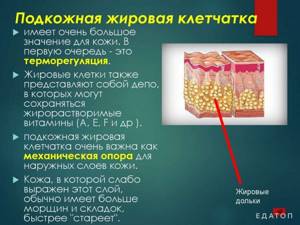
Subcutaneous fat performs many important functions in the human body.
Energy
During the breakdown of 1 g of fat, the body receives 9 kcal. 1 kg will give 9000 kcal, which in case of stress will allow you to survive on internal reserves for about 6-9 days with economical expenditure of energy. However, it must be taken into account that normally fats cover only 30% of the daily energy value of the diet and do not provide vitamins and minerals.
Protective
The protective function is due to the fact that fat reliably protects internal organs from the negative effects of the external environment. The top layer of skin cannot cope with this task because it is not dense and durable enough. Fat minimizes mechanical impact: it prevents injury from impacts and falls. The layer protects the body from sudden temperature changes. If there is enough fat, the skin becomes more elastic and it is prevented from tearing.
Thermal insulating
Fat can retain heat. It heats up and cools relatively slowly, so it allows you to maintain a stable temperature in hot and cold weather.
However, with excess lipids in summer, a person experiences discomfort.
Accumulation
Some beneficial substances are not able to dissolve in water, but are well retained by fats. This applies, for example, to retinol and tocopherol. Estrogens, female sex hormones, accumulate in adipose tissue. For this reason, in overweight men, the production of testosterone is disrupted, and their figure takes on feminine contours.
Hormone production
Adipose tissue is capable of independently producing hormones. First of all, these are substances that control appetite and give a feeling of fullness. However, with an excess of fat, the synthesis of some hormones is inhibited, the rest are no longer accepted well enough by the body, which has the opposite effect. The result is a vicious circle: hunger increases due to lipids, and lipids accumulate due to overeating.
What is a “belly” and where does it come from?
….maybe this information will help someone get rid of a belly fat, and someone will not get it….
(...recommended for reading “Losing Weight with “Sloboda”!!!)
We already have abs, but they are not visible because they are hidden under a layer of fat. If you want to see it, you need to take steps to reduce fat and increase abdominal muscle definition. Formula for 6-pack abs - Fat burning + Muscle hypertrophy = Visible abs In Figure B, the abs are visible because the body has a lower percentage of fat, water and hypertrophied muscles, in Figure. And the amount of subcutaneous fat and water is greater

Visceral fat: Fat surrounding internal organs; Causes “beer belly”; Efforts are required to reduce it; Associated with cardiovascular disease, high blood pressure and diabetes. Subcutaneous fat: Fat found under the skin; We see it when the skin is caught in a fold; Has less negative impact on the heart; Easier to decrease than visceral.
There are only a few ways to effectively remove belly fat: Fat burning Abdominal muscle training Normalization of hormonal levels Liposuction Sports pharmacology
The main reasons for the appearance of a belly: Abdominal obesity - the appearance of excess subcutaneous fat; the formation of fats located around the internal organs behind a layer of muscles. Weakening and stretching of the abdominal muscles; Enlargement of the abdominal organs (splenomegaly, hepatomegaly, megacolon); Diseases (increased cortisol levels, kwashiorkor, rickets, insulin resistance and type 2 diabetes mellitus) Alcohol consumption Eating disorders (lack of complete protein, excess simple sugars, especially fructose) According to the WHO classification, with a waist circumference of more than 94 cm in men and more than 80 cm in Women have an increased risk of developing obesity-related diseases. There are various ways to measure abdominal obesity, including: Absolute waist circumference (WA > 102 cm in men and > 88 cm in women) Waist-to-hip ratio (waist to hip circumference > 0.9 for men and > 0.85 for women) The indicator for determining excess weight is the Body Mass Index (BMI). BMI = body weight/height2 (kg/m2). The Bornhardt index is also used, unlike BMI, which takes into account a person’s physique. MRI is considered the most accurate method for determining the amount of fat tissue in the body. In everyday life, the amount of adipose tissue in the human body is usually determined by household scales with a body composition analyzer using the bioimpedance metry method.
How to remove belly fat? Abdominal exercises. Without eliminating the causes, it is impossible to remove a large belly and get sculpted abs with cubes. Sometimes only one causative factor is important (in the case of a disease), but often several subclinical factors are superimposed at once. It is necessary to apply an integrated approach to solving interrelated problems. A study published in the International Journal of Sport Nutrition and Exercise Metabolism suggests that combining aerobic exercise with resistance training is more effective than doing aerobic exercise alone. An additional benefit of these workouts: increased stress resistance and insulin levels, which in turn reduces cortisol, which promotes fat storage.
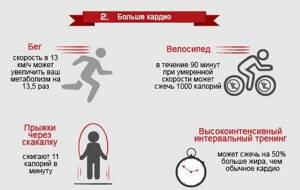
When performing various physical exercises, you not only strengthen your abs, but also expend energy, which leads to effective fat burning. By increasing the endurance and strength of the abdominal muscles, you also help improve blood circulation and normalize the functioning of the intestines, on which movements during abdominal training act like a light massage. Research from the San Diego Institute of Biomechanics (USA) has shown that among abdominal exercises there are those in which the electrical activity of the muscles is higher than in others. In particular, using electromyography, measurements were taken of each of the subsequent muscle groups - rectus, external/internal obliques, for their activation in certain exercises. The results of the study gave such a list of the best abdominal exercises in general and for each department in particular.
As for the best exercises for individual abdominal muscles, the situation is as follows: rectus/obliques. — fitball crunches, reverse crunches, roller, plank, hanging knees on the wall bars, vertical crunches (legs raised) lying on the floor, crunches with arm and torso raises, roller; bicycle crunches, side crunches lying on the floor. The best exercise aimed at developing core strength is the plank.
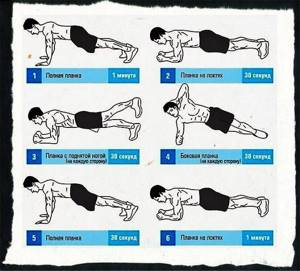
Ways to lose weight
For effective quick effects on the waist and abdomen, you should train the muscles of the whole body. The consumption of fat by the body manifests itself not only in the place where the exercises are aimed at solving the problem, but also in the entire body as a whole. For example, during squats, not only fat deposits on the legs are burned, but also on the entire body. That is why physical activity should be comprehensive and aimed at all muscle groups.
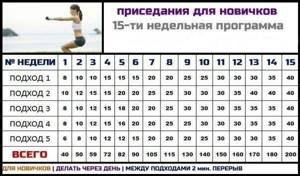
The more varied the exercises included in your daily workouts, the faster your stomach will become toned. A sports program should have an impact on the whole body; strong muscles expend energy well, which means they quickly get rid of excess subcutaneous fat.
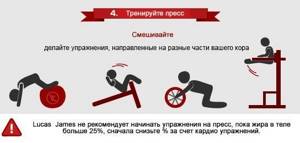
The basic rule that will lead you to success is the solution of two main tasks: - organizing proper balanced nutrition;
- regularly perform a set of exercises to burn excess fat.
Exercise vacuum
Professional fitness instructors recommend the vacuum exercise for a flat stomach. To obtain visible results, you must perform it daily for 3 weeks. Technique for performing the exercise The result depends on the efforts made and the correct technique for performing this exercise. Do it twice a day: in the morning on an empty stomach and in the evening (a couple of hours before dinner). The duration of one lesson is 5-10 minutes. “Vacuum” can be performed in three initial body positions: Standing , feet shoulder-width apart, slightly leaning forward, knees slightly bent, buttocks slightly back, hands resting on the legs in the area just above the knees.

Lying on your back, legs bent at the knees and standing on the floor. You need to perform a “vacuum” from this position if you cannot hold on or if it is uncomfortable for you to do it from position 1.

Kneeling , emphasis on straight arms, rounded back. Now gently exhale the air from your lungs so that it comes out completely. Hold your breath for a couple of seconds, drawing in your stomach and tensing your abdominal muscles as much as possible.
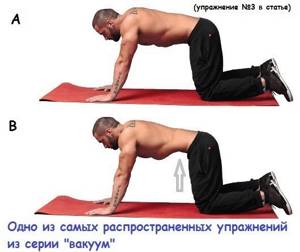
Then inhale slowly, and as you exhale, repeat drawing in your stomach and tensing your abdominal muscles. Inhale through the nose, exhale through the mouth, through pursed lips. There is another variation of this exercise: the starting body positions are the same, but the technique is different. We exhale all the air, then take a shallow breath, hold our breath and tense our abdominal muscles, then continue to inhale and hold and tense again - we do this until we inhale completely. We repeat the same with exhalation. To begin with, you can practice without holding your breath, simply inhaling and exhaling, alternately drawing in and inflating your stomach. By the way, such retractions and inflations are recommended to be done after childbirth to reduce the volume of the abdomen and tone the abdominal muscles. The number of repetitions should be increased gradually. Start with 2-3 times and eventually work your way up to 10-15.
Proper nutrition Not even the most effective set of physical exercises and intense workouts will help you if you don’t eat right or overeat immediately after exercise.
To achieve noticeable results, adjust your diet. The speed and effectiveness of solving the problem directly depends on nutrition. For successful weight loss, WHO recommends calculating the usual caloric intake of food, and then monthly reducing the caloric intake by 500 kcal until a figure is 300-500 kcal below the adequate energy requirement. For persons not engaged in active physical labor, this value is 1,500–2,000 kcal. Basic recommendations when following a diet: consumption of foods with a high content of fiber, vitamins and other biologically active components (cereals and whole grains, vegetables, fruits, nuts, herbs, etc.) and limiting the consumption of carbohydrates easily digestible by the body (sugar, sweets, baked goods, baked goods and pasta made from premium flour).
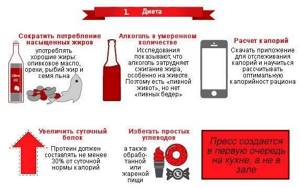
Remember: when you consume an amount of food that exceeds the norm, your body does not burn fat, but only accumulates it, and at the same time, even more extra pounds appear. A prerequisite for getting rid of fat and belly fat is to create an energy deficit.
Belly fat neutralizes dihydrotestosterone. Deposits on the sides and abdomen of men have a negative impact on overall health. Scientists from the Canadian University of Laval have identified new types of effects of fat deposits on the body. Enzymes in adipose tissue not only convert testosterone to estradiol, but also convert dihydrotestosterone into inactive components. Overweight men often have a lack of androgen hormones. In clinical settings, doctors typically address this by prescribing antiestrogens such as letrozole and courses of testosterone therapy. But testosterone injections cannot be the only remedy. The more body fat a person has, the weaker the response to testosterone therapy and the more side effects. The more fat, the more enzymes in the body that deactivate dehydrotestosterone. The latter, as a result of contact with adipose tissue, is converted into 5-alpha-androstane 3-alpha, 17-beta-diol and 5-alpha-androstane 3-beta, 17-beta-diol. Anti-estrogens are no longer able to prevent this conversion. When studying subcutaneous and abdominal fat in obese and thin men, scientists found that the highest degree of conversion of dihydrotestosterone occurs in subcutaneous fat. The most active enzymes are found in adult fat cells - adipocytes. While immature fat cells - preadipocytes do not show such activity in converting dihydrotestosterone. The more body fat you have, the more dihydrotestosterone is converted in your body. The more fat, the higher the conversion activity of adipocytes. What are the dangers of reducing the amount of dihydrotestosterone? And the fact is that reduced or zero formation of dihydrotestosterone and from testosterone is associated with one of the forms of testicular feminization syndrome - tissue insensitivity to testosterone. That is, the main male sex hormone loses its ability to act on target cells and tissues, causing the necessary biological changes in them.
Belly fat increases risk of death
A study conducted by a team of scientists from the US National Institutes of Health found that people with normal weight and abdominal obesity were twice as likely to die compared to people who were overweight or obese according to BMI.

This is because central obesity is associated with increased accumulation of visceral fat, which is stored around a number of internal organs such as the liver, pancreas and intestines. And visceral fat, according to experts, is more harmful and can lead to insulin resistance, and this in turn becomes a harbinger of type 2 diabetes, entails high cholesterol and many chronic diseases.

Be healthy !
Key indicators for men and women
There are several ways to define indicators. The first involves the use of a caliper. This is a device that measures the thickness of the skin fold. The second method is simpler, but less accurate. A person stands on a special scale that calculates the percentage of body fat. The last method is hydrostatic weighing. It is used only in specialized institutions. A person lies down in a bathtub filled with water. The volume of displaced water is then calculated and compared to the client’s weight. This is the most accurate but complex method. In everyday life, scales are often used.
Norm
The normal value depends on the gender and age of the person. The data is shown in the table below.
| Age, years | Norm for a woman, % | Norm for a man, % |
| 18-29 | 19-26,9 | 8-17,9 |
| 30-39 | 21-28,9 | 11-19,9 |
| 40-49 | 22-29,9 | 11-21,9 |
| 50-59 | 23-30,9 | 12-23,9 |
| Over 60 | 24-31,9 | 13-24,9 |
Excess
Excess is set on average at 27-32 for women and 18-25 for men. If a girl's lipid percentage exceeds 30, she is diagnosed with obesity. For men, the critical mark is 23-24; after 40 years, it moves to 27-28.
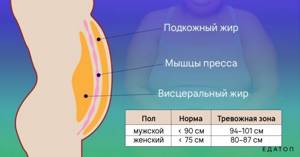
The norm of subcutaneous fat content is different for women and men.
Shortage
An insufficient indicator is 18.9-23.9 for women and 7.9-12.9 for men, depending on age. With a lack of fat, apathy and lethargy are observed. Hormonal imbalance occurs and the condition of hair and skin worsens. Metabolism is disrupted: the body does not retain fat-soluble nutrients well and slowly removes toxins. The risk of inflammation increases.
What else is visceral fat dangerous for?
According to research from Johns Hopkins Medical Institutions, visceral fat is metabolized by the liver, which converts it into cholesterol that circulates in the blood. “Bad” cholesterol (low-density lipoprotein, or LDL) accumulates in the arteries, where it forms plaques that narrow the blood vessels.
Visceral fat can increase insulin resistance (decreased responsiveness of insulin-sensitive tissues to the effects of insulin), which in turn can lead to glucose intolerance and type 2 diabetes. This effect is found even in people who have never had diabetes or prediabetes. It is due to the fact that visceral fat secretes retinol-binding protein, which increases insulin resistance, according to an article published in the medical library of the US National Center for Biotechnology Information.
Excess visceral fat increases the risk of developing several serious life-threatening conditions. These are heart attacks and heart disease, type 2 diabetes, stroke, breast cancer, colon cancer, Alzheimer's disease.

I have. Why extra pounds are especially dangerous for older people Read more
Sources of fat in food
Edible fats of vegetable or animal origin. Vegetable fats are obtained from the seeds or fruits of oilseeds, animal fats from the tissues or milk of terrestrial animals, and from the tissues of marine animals. Sources of animal fat (except for edible fats: butter, lard, bacon, etc.) are meat and sausages, fish, eggs and dairy products. Depending on the type and age of the animal and the part of the carcass, fat content can vary widely
- in meat from 3 to 55%;
- fish contains 0.1-13% fat,
- whole milk about 3-3.5%,
- cottage cheese about 1-9%,
- rennet cheese about 17-30%,
- processed cheese about 30%
- eggs about 11% fat.
Cereals and margarine are the main sources of vegetable fats, while edible oils and vegetables are smaller. It is believed that grain fat makes up about 20% of the total amount of vegetable fat consumed, and margarine - about 60%. The consumption of liquid vegetable oils in our country is low, which is due to eating habits and culinary traditions.
Only plant foods and fish provide significant amounts of essential unsaturated fatty acids. A lot of linoleic acid is found in edible oils (corn, sunflower, soybean).
Alpha-linolenic acid is found mainly in plant chloroplast membranes and in smaller quantities in seeds and oils. Marine fish oils are also a good source from the n-3 group.
Saturated fat
| acid name | food sources | action |
| myristic, palmitic, lauric acid | milk fat | increase in LDL cholesterol |
| stearic acid, myristic acid | solid fats | prothrombotic |
| peanuts, behenic acid | atherogenic |
Polyunsaturated fatty acids (PUFAs) from the n-6 family
| acid name | food sources | action |
| linoleic, arachidonic, docosapentaene | soybean, sunflower, corn and grape oil | reduce total cholesterol and LDL cholesterol |
Polyunsaturated fatty acids (PUFAs) from the n-3 family
| α-linolenic | rapeseed, soybean, linseed oil | reduce triglycerides, reduce total cholesterol and LDL cholesterol |
| eicosapentaenoic acid (EPA), docosahexaenoic acid (DHA) | fatty sea fish: mackerel, pickling, herring | reduce triglycerides, reduce total cholesterol and LDL cholesterol |
Monounsaturated fatty acids (MUFAs)
| acid name | food sources | action |
| oleic | olive oil, rapeseed oil | reduce total cholesterol and LDL cholesterol |
Division and structure of fats
Fats are divided into:
- simple (triacylglycerols and waxes, they include the elements: carbon, hydrogen and oxygen)
- complex (phospholipids and glycolipids, which in addition to the listed elements include: phosphorus, sometimes nitrogen or sulfur).
The main component of dietary fats are triglycerides, that is, esters consisting of three molecules of fatty acids and one molecule of glycerol. Triglycerides found in the body come from food and endogenous synthesis (in the liver, adipose tissue, small intestinal mucosa, mammary gland).
Fatty acids differ in carbon chain length, that is, the number of carbon atoms in the molecule, and the number and arrangement of double bonds. These acids are composed of carbon, hydrogen and oxygen. The number of carbon molecules in fatty acids is 4-26. Depending on the length of the carbon chain they are divided into:
- short chain – up to 6 carbon atoms per molecule,
- middle chain – 8-10 carbon atoms
- a long chain containing 12 or more carbon atoms per molecule.
Short- and medium-chain acids are less common in edible fats (such as milk and butter fats) than long-chain acids (they are found in all vegetable and animal fats).
Fatty foods and lipid body can be:
- saturated fatty acids (saturated fatty acids - SFAs, when there is no double bond between carbon atoms, and all carbon atoms are not connected to hydrogen atoms),
- monounsaturated fatty acids (monounsaturated fatty acids – MUFAs have one double bond between two adjacent carbon atoms)
- polyunsaturated fatty acids (polyunsaturated fatty acids - PUFAs have at least two double bonds).
How to get rid of visceral fat?
Harvard experts say diet and exercise can help reduce visceral fat. They may be even more effective than reducing subcutaneous fat. It often happens that obese people do not yet see the visual effect of changing diet and exercise, but the fat around their organs has begun to decrease.
People with excess visceral fat are advised to exercise for at least 30 minutes every day. It is advisable to include both cardio exercises and strength training.
You should also change your eating habits by eliminating processed foods that are high in sugar and fat and incorporating more lean sources of protein, vegetables, and complex carbohydrates into your diet. Instead of frying foods, they should be boiled or baked.
People with frequent stress can practice meditation, deep breathing and other stress management techniques. It is also recommended to get enough sleep regularly, quit smoking and limit alcohol consumption.
Trans fats, trans isomers
Trans isomers are formed under the influence of temperature, various physical and chemical factors during the industrial refining of oils and during hydrogenation during the production of margarines. The transition of fatty acids into trans forms entails a change in their biological value and effect on the body. Trans isomers are also formed in the stomach of ruminants and pass into milk and tissues. However, the amount of trans acids found in butter is much less than in refined oils or hard margarines.
The main sources of trans isomers in food products are margarines, shortenings, confectionery oils and fats repeatedly used for frying. They can be found in products such as confectionery, cookies, candies and fast food products. Trans isomers increase the concentration of cholesterol in the human body to the same extent as saturated fatty acids and further reduce the concentration of cholesterol (the so-called good cholesterol).





